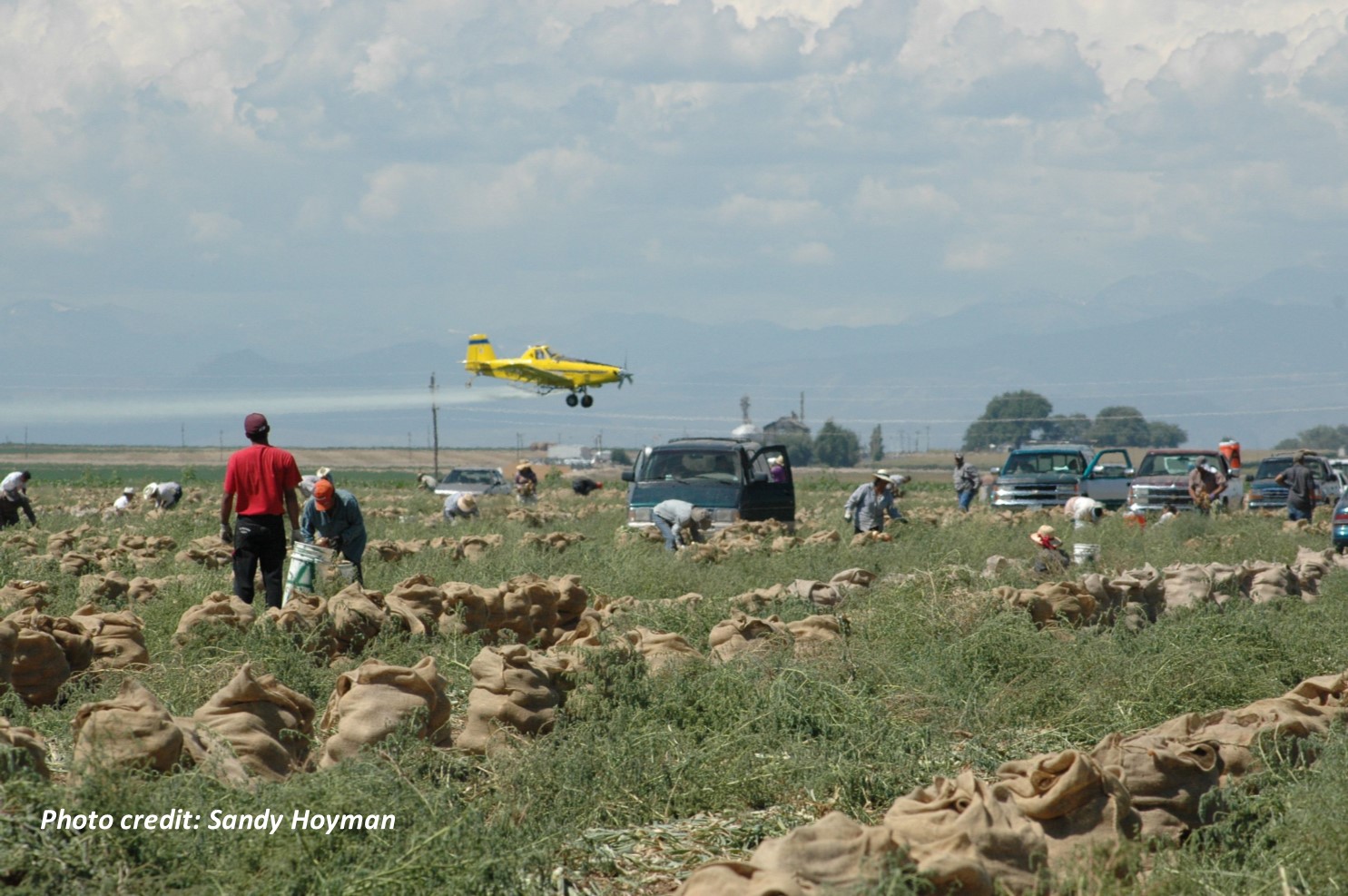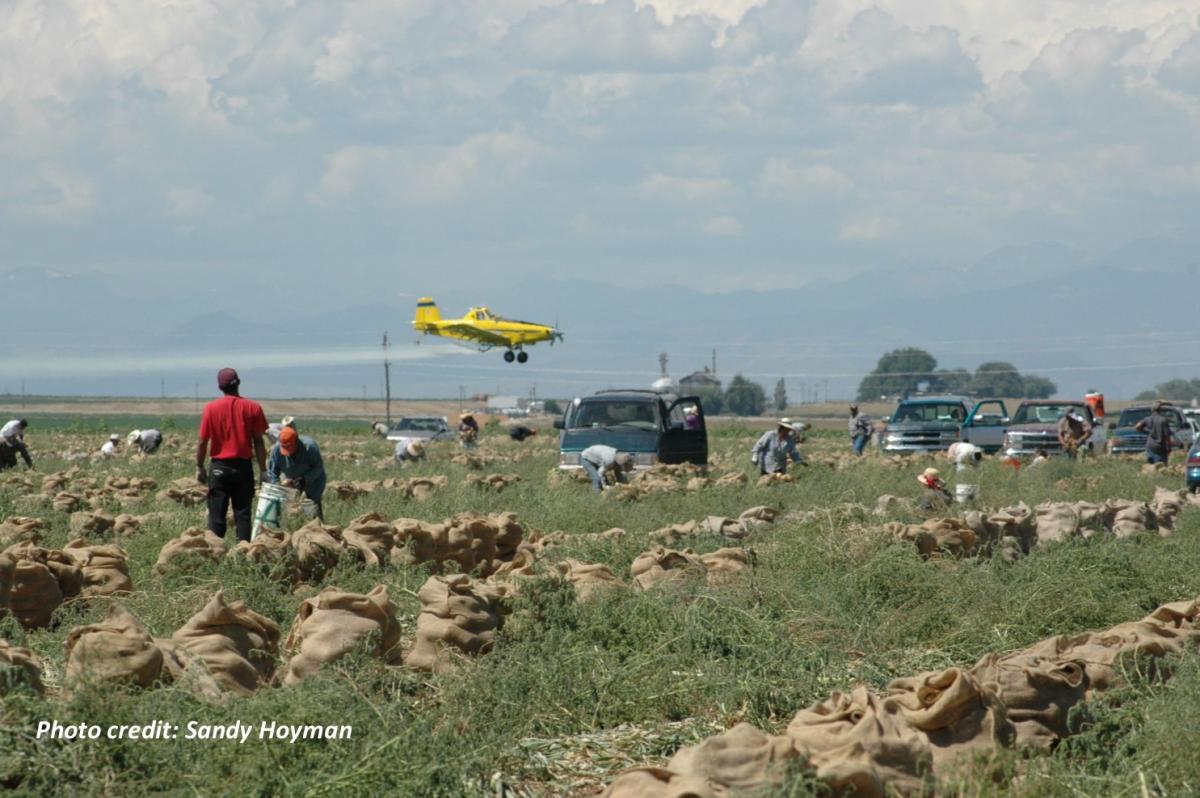National Farmworkers Awareness Week Blog: Dangerous pesticide chlorpyrifos banned in Maryland

Last week, Maryland became the fourth state in the U.S. to ban chlorpyrifos, thanks to the tireless efforts of a broad coalition of farmworker, environmental and public health advocates. The ban will take effect on January 1, 2021 and will sunset in 2024. It also provides some limited waivers for certain crops. In spite of these limitations, the bill is still a significant victory for the health of Maryland’s farmworkers and general population. Farmworker Justice’s Senior Staff Attorney Iris Figueroa testified in favor of the chlorpyrifos ban before the Maryland General Assembly last month.
 Chlorpyrifos is a highly neurotoxic insecticide developed from World War II-era nerve gas. In addition to the developmental dangers it poses to babies, exposure can cause dizziness, vomiting, convulsions, numbness in the limbs, loss of intellectual functioning and death. Toxic pesticides like chlorpyrifos are just one of the many ways in which farmworkers and their families are routinely exposed to high levels of pesticides in the fields where they work and the communities where they live. Farmworkers’ persistent exposure to pesticides results in thousands of reported pesticide poisonings, illnesses and injuries each year. Even the children of farmworkers cannot avoid exposure due to the proximity of their homes, schools and playgrounds to the fields where pesticides are applied.
Chlorpyrifos is a highly neurotoxic insecticide developed from World War II-era nerve gas. In addition to the developmental dangers it poses to babies, exposure can cause dizziness, vomiting, convulsions, numbness in the limbs, loss of intellectual functioning and death. Toxic pesticides like chlorpyrifos are just one of the many ways in which farmworkers and their families are routinely exposed to high levels of pesticides in the fields where they work and the communities where they live. Farmworkers’ persistent exposure to pesticides results in thousands of reported pesticide poisonings, illnesses and injuries each year. Even the children of farmworkers cannot avoid exposure due to the proximity of their homes, schools and playgrounds to the fields where pesticides are applied.
In 2000, the US Environmental Protection Agency (EPA) banned the use of the pesticide chlorpyrifos in residential settings because of emerging evidence that it posed unacceptable risks to young children. But the agency allowed continued use of the pesticide in agriculture, a double standard that has exposed an entire generation of farmworkers and their families through airborne drift, water contamination, and even the residues on workers’ clothes. In 2017, former EPA Administrator Scott Pruitt rejected the recommendations of the EPA’s own scientists and refused to ban further agricultural uses of chlorpyrifos, even though the agency’s own risk assessment found that there are no safe levels of the pesticide in food or water, that unsafe exposures to farmworkers continue on average 18 days after applications, and that workers who mix and apply chlorpyrifos are exposed to unsafe levels even when using protective gear.
In response to the EPA’s decision to ignore its own science, Earthjustice, Farmworker Justice and various other organizations filed a lawsuit seeking a federal chlorpyrifos ban.
While EPA continues to delay action to ban chlorpyrifos, lawmakers at the federal and state level are also taking action. At the federal level, last year Sen. Tom Udall (D-NM) introduced the “Protect Children, Farmers and Farmworkers from Nerve Agent Pesticides Act of 2019”and Rep. Nydia Velasquez (D-NY) introduced similar legislation, the “Ban Toxic Pesticides Act of 2019.” These bills would ban all food uses of chlorpyrifos.
Several states have also banned use of the pesticide at the state level, including Hawaii, New York and California. Maryland has now become the fourth state to join this list, and only the second state to do so via legislation, providing decisive protections in the face of federal inaction. Similar efforts to ban chlorpyrifos are currently underway in other states, including Oregon, Washington and Connecticut. Farmworker Justice applauds these state and federal efforts to take swift action where EPA has failed to uphold its mission to protect human health and the environment.
Last week, Maryland became the fourth state in the U.S. to ban chlorpyrifos, thanks to the tireless efforts of a broad coalition of farmworker, environmental and public health advocates. The ban will take effect on January 1, 2021 and will sunset in 2024. It also provides some limited waivers for certain crops. In spite of these limitations, the bill is still a significant victory for the health of Maryland’s farmworkers and general population. Farmworker Justice’s Senior Staff Attorney Iris Figueroa testified in favor of the chlorpyrifos ban before the Maryland General Assembly last month.
 Chlorpyrifos is a highly neurotoxic insecticide developed from World War II-era nerve gas. In addition to the developmental dangers it poses to babies, exposure can cause dizziness, vomiting, convulsions, numbness in the limbs, loss of intellectual functioning and death. Toxic pesticides like chlorpyrifos are just one of the many ways in which farmworkers and their families are routinely exposed to high levels of pesticides in the fields where they work and the communities where they live. Farmworkers’ persistent exposure to pesticides results in thousands of reported pesticide poisonings, illnesses and injuries each year. Even the children of farmworkers cannot avoid exposure due to the proximity of their homes, schools and playgrounds to the fields where pesticides are applied.
Chlorpyrifos is a highly neurotoxic insecticide developed from World War II-era nerve gas. In addition to the developmental dangers it poses to babies, exposure can cause dizziness, vomiting, convulsions, numbness in the limbs, loss of intellectual functioning and death. Toxic pesticides like chlorpyrifos are just one of the many ways in which farmworkers and their families are routinely exposed to high levels of pesticides in the fields where they work and the communities where they live. Farmworkers’ persistent exposure to pesticides results in thousands of reported pesticide poisonings, illnesses and injuries each year. Even the children of farmworkers cannot avoid exposure due to the proximity of their homes, schools and playgrounds to the fields where pesticides are applied.
In 2000, the US Environmental Protection Agency (EPA) banned the use of the pesticide chlorpyrifos in residential settings because of emerging evidence that it posed unacceptable risks to young children. But the agency allowed continued use of the pesticide in agriculture, a double standard that has exposed an entire generation of farmworkers and their families through airborne drift, water contamination, and even the residues on workers’ clothes. In 2017, former EPA Administrator Scott Pruitt rejected the recommendations of the EPA’s own scientists and refused to ban further agricultural uses of chlorpyrifos, even though the agency’s own risk assessment found that there are no safe levels of the pesticide in food or water, that unsafe exposures to farmworkers continue on average 18 days after applications, and that workers who mix and apply chlorpyrifos are exposed to unsafe levels even when using protective gear.
In response to the EPA’s decision to ignore its own science, Earthjustice, Farmworker Justice and various other organizations filed a lawsuit seeking a federal chlorpyrifos ban.
While EPA continues to delay action to ban chlorpyrifos, lawmakers at the federal and state level are also taking action. At the federal level, last year Sen. Tom Udall (D-NM) introduced the “Protect Children, Farmers and Farmworkers from Nerve Agent Pesticides Act of 2019”and Rep. Nydia Velasquez (D-NY) introduced similar legislation, the “Ban Toxic Pesticides Act of 2019.” These bills would ban all food uses of chlorpyrifos.
Several states have also banned use of the pesticide at the state level, including Hawaii, New York and California. Maryland has now become the fourth state to join this list, and only the second state to do so via legislation, providing decisive protections in the face of federal inaction. Similar efforts to ban chlorpyrifos are currently underway in other states, including Oregon, Washington and Connecticut. Farmworker Justice applauds these state and federal efforts to take swift action where EPA has failed to uphold its mission to protect human health and the environment.

